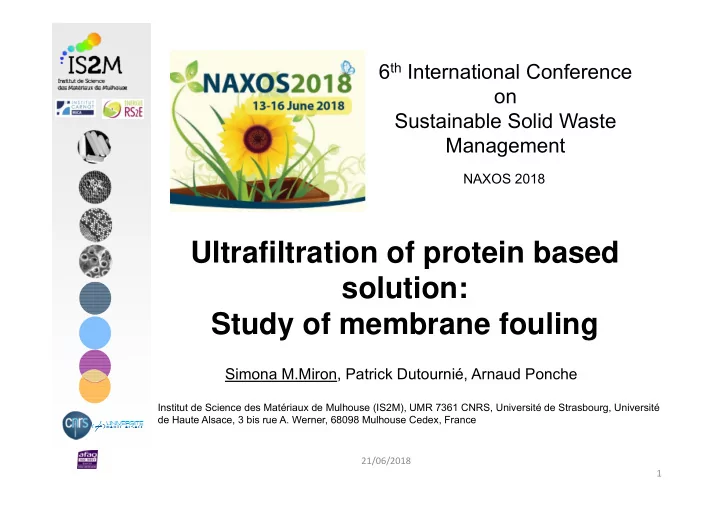

6 th International Conference on Sustainable Solid Waste Management NAXOS 2018 Ultrafiltration of protein based solution: Study of membrane fouling Simona M.Miron, Patrick Dutournié, Arnaud Ponche Institut de Science des Matériaux de Mulhouse (IS2M), UMR 7361 CNRS, Université de Strasbourg, Université de Haute Alsace, 3 bis rue A. Werner, 68098 Mulhouse Cedex, France 21/06/2018 1
Conclusions Materials and Introduction Results and discussion and future work methods Outline • Introduction • Study cases 1. Study of interactions between biomolecules and material through cross ‐ flow filtration ‐ Study of fouling behavior 2. Study of biological activity of the filtrated solutions • Conclusions 2
Conclusions Materials and Introduction Results and discussion and future work methods Ultrafiltration Membrane process Separate, concentrate, rectify and purify Water and wastewater treatment Biopharmaceutical industry Food and diary industry 3
Conclusions Materials and Introduction Results and discussion and future work methods Part 1. Study of interactions between biomolecules and material through cross ‐ flow filtration Study of fouling behavior 4
Conclusions Materials and Introduction Results and discussion and future work methods Hen egg white lysozyme ‐ enzyme with 129 amino acids ‐ antimicrobial activity against Gram ‐ positive bacteria Ribbon diagram of HEWL Amino acid L-tyrosine Elementary constituent of Lysozyme Neutral solution Vitamin B12 Used for membrane performances investigation (Mean pore radius calculation using Nernst-Plank model) 5
Conclusions Materials and Introduction Results and discussion and future work methods Membrane characteristics : Membrane performances: ‐ ultrafiltration membrane ‐ bilayer membrane of TiO 2 1. Selectivity performances: ‐ asymmetrical pore structure rejection rate (R) ‐ cut ‐ off 1 kDa 2. Hydraulic performances: Membrane Membrane permeability (Lp) Feed Retentate Permeate 6
Conclusions Materials and Introduction Results and discussion and future work methods Calculated R max Lp N° Test Solution Pore radius (10 ‐ 14 m 3 .m ‐ 2 (%) memb ) (nm) Pure water after conditioning step 6.2 1 L ‐ tyrosine 5 4.7 2 VB12 57 1.61 4.1 3 Lysozyme 85 3.6 4 Lysozyme 93 3.3 5 VB12 75 1.27 3.2 6 Lysozyme 98 3.1 7 VB12 86 1.09 2.4 8 L ‐ tyrosine 6.5 2.3 Decrease in lysozyme transmission and in hydraulic permeability adsorption ? Pore clogging ? 7
Conclusions Materials and Introduction Results and discussion and future work methods 90 r p = 1.09 nm test 3 Test 2 80 test 6 Test 5 r p = 1.27 nm Test 7 test 10 70 Rejection rate (%) 60 r p = 1.61 nm 50 40 30 0,0E+00 2,0E ‐ 05 4,0E ‐ 05 6,0E ‐ 05 8,0E ‐ 05 Permeation flux (m 3 .m ‐ 2 .s ‐ 1 ) Membrane selectivity increases, hydraulic performances decreases calculated pore radius decreases 8
Conclusions Materials and Introduction Results and discussion and future work methods Conclusions from filtration tests • membrane hydraulic performances • selectivity properties • lysozyme transmission and hydraulic permeability Adsorption of protein pore clogging • Tyrosine filtration after Lysozyme – no variation • Tyrosine filtration before lysozyme (clean membrane) - significant effect Adsorption of lysozyme in pores increases selectivity and decreases hydraulic performances. 9
Conclusions Materials and Introduction Results and discussion and future work methods HPLC analysis of lysozyme Retentate Lysozyme reference sample Lysozyme II Membrane M2 pressure 4 bar 100 Lysozyme II Membrane M2 pressure 6 bar 9.81 Lysozyme II Membrane M2 pressure 8 bar Lysozyme II Membrane M2 pressure 10 bar 80 Lysozyme II Membrane M2 pressure 12 bar Response[mAU] 60 40 20 0 7 8 9 10 11 12 13 14 15 Retention time (min) No modification of the lysozyme molecule (no time/ shear stress effect) 10
Conclusions Materials and Introduction Results and discussion and future work methods HPLC analysis of lysozyme Permeate Lysozyme reference sample 9.81 10.22 Lysozyme II Membrane M2 pressure 4 bar 1,0 Lysozyme II Membrane M2 pressure 6 bar Lysozyme II Membrane M2 pressure 8 bar Lysozyme II Membrane M2 pressure 10 bar Lysozyme II Membrane M2 pressure 12 bar 0,8 Normalized response 0,6 0,4 0,2 0,0 7 8 9 10 11 12 13 14 15 Retention time (min) Modification of the lysozyme molecule after permeation (denaturated) 11
Conclusions Materials and Introduction Results and discussion and future work methods HPLC analysis of lysozyme of denatured population of molecules after filtration 12
Conclusions Materials and Introduction Results and discussion and future work methods Part 2. Study of biological activity of the filtrated solutions Lysozyme Micrococcus lysodeikticus 13
Conclusions Materials and Introduction Results and discussion and future work methods Lysozyme assay 0,40 Retentate Native Permeate 0,35 Abs (450nm) 0,30 0,25 0,20 0 100 200 300 400 Time [s] Loss of activity Sample Unit/mg ‐ 83 926 Native ‐ 85 528 Retentate 20 % Permeate 68 929 Retentate shows slightly higher activity than permeate 14
Conclusions Materials and Introduction Results and discussion and future work methods Conclusions/observations • Protein adsorption in larger pores (modification of membrane performances ‐ > Partial fouling) • HPLC : 2 populations of lysozyme with different hydrodynamic radii in retentate and permeate (denaturation) • Loss of conformation not correlated to a huge diminution of bacterial activity 15
Σας ευχαριστώ για την προσοχή σας W Thank you for your attention V ă mul ţ umesc pentru aten ţ ie 16
6 th International Conference on Sustainable Solid Waste Management NAXOS 2018 Ultrafiltration of protein based solution: Study of membrane fouling Simona M.Miron, Patrick Dutournié, Arnaud Ponche Institut de Science des Matériaux de Mulhouse (IS2M), UMR 7361 CNRS, Université de Strasbourg, Université de Haute Alsace, 3 bis rue A. Werner, 68098 Mulhouse Cedex, France 21/06/2018 17
Recommend
More recommend